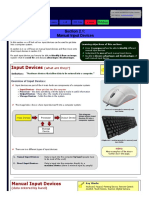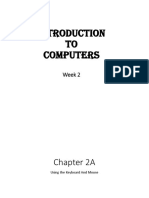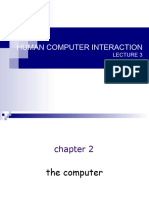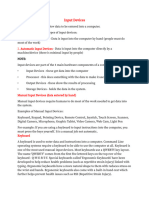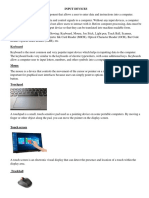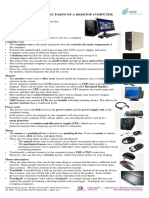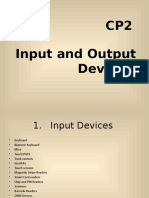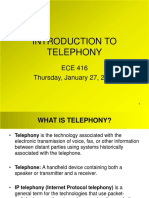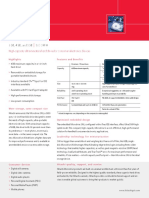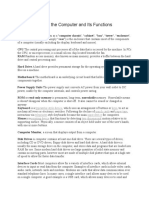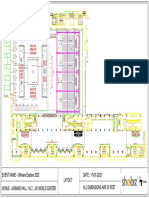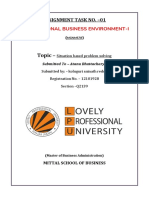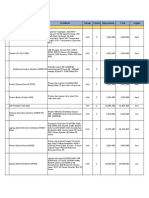INPUT DEVICES
Lecture 3
�Last Lecture Summary
Computer Hardware
Processor, Memory, Motherboard
Input Devices
Output Devices
Communication devices
Storage Devices
Magnetic storage devices, Floppy Hard disk
Optical storage devices, CD, DVD, Blu Ray
Computer Software
System software and Application software
Computer Users
2
� Using the input devices
CPU is computer brain the input
devices are its sensory organs
From user point of view, input device
are important
Enables user to enter information and
commands into the computer
Two common input devices
Keyboard
Mouse
3
� Input Devices
Hardware used to enter data and
instructions
4
� Two Common Input Devices
Keyboard
Mouse
5
�The Keyboard
First peripheral to be used with computers
The most common input device for
inputting text and numbers
About 100 keys
Must be proficient with keyboard
Skill is called keyboarding
6
�Standard Keyboard
Layout
IBM Enhanced Keyboard with 101 keys
7
� Five Groups of Keys
Alphanumeric Keys
Modifier Keys
Numeric Keypad
Function Keys
Cursor Movement keys
8
�9
�Alphanumeric Keys
Area of computer that looks like
a typewriter
Sometimes called QWERTY
Keys having specific functions
Tab
Caps Lock
Backspace
Enter
10
�Modifier Keys
Shift
Alt (Alternate)
Ctrl (Control)
Modify the input of other keys
11
� Numeric Keypad
usually located on the
right side of the
keyboard,
Has 10 digits and
mathematical operators
(+, -, *, and /).
also features a NumLock
key
On - forces the numeric
keys to input numbers.
Off - perform cursor
movement control and
other functions.
12
� Function Keys
labeled F l, F2, and so on
in a row along the top of the keyboard.
allow you to input commands without typing long
strings of characters or navigating menus or dialog
boxes.
Each key's purpose depends on the program you are
using.
Many programs use function keys along with modifier
keys to give the function keys more capabilities.
13
�Cursor Movement Keys
let you move around the
screen without using a
mouse.
Cursor is a mark on the
screen indicates where the
characters you type will be
entered
Arrow Keys
Home and End
PgUp and PgDn
14
�Special Purpose Keys
Esc (Escape)
Insert
Delete
PrtSc (Print Screen)
ScrLk (Scroll Lock)
Pause
Two special for Microsoft Windows
Start
Shortcut
15
�Internet and Multimedia
Controls
One of the latest trends is
the addition of Internet and
multimedia controls.
Microsoft's Internet
Keyboard and MultiMedia
Keyboard,
e.g. you can use the buttons
to launch a Web browser,
check e-mail and start your
most frequently used
programs.
Multimedia buttons
control the computer’s CD-
ROM or DVD drive
adjust the speaker volume
16
�How Keyboard Works
Key is pressed on keyboard
Keyboard controller detects a key press
Keeps the code in its memory, Keyboard
buffer
Code represents the key pressed
Controller notifies the operating system
via an interrupt
Operating system responds the
interrupt by the reading the code from
buffer
OS passes the code to CPU
17
�QWERTY Keyboard
Layout
Latham Sholes' 1878 QWERTY
keyboard layout
18
�Non-standard layout and special-use
Chorded keyboard
Software or virtual keyboard
Foldable keyboard
Projection (as by Laser)
19
�Chorded Keyboard
Associate actions with combinations of key
presses
As many combinations available, chorded
keyboards can effectively produce more
actions on a board with fewer keys
Court reporters mostly use them
20
�Software or Virtual Keyboards
is a software component that allows a
user to enter characters.
usually be operated with multiple input
devices,
Touch screen,
Actual keyboard and
Mouse.
21
�Foldable Keyboards
made of soft plastic or silicone
which can be rolled or folded
on itself for travel
When in use, these keyboards
can conform to uneven
surfaces, and
are more resistant to liquids
than standard keyboards.
connected to portable devices
and smart phones.
22
�Projection Keyboard
project an image of keys, usually with a laser, onto a
flat surface.
The device then uses a camera or infrared sensor to
"watch" where the user's fingers move
Projection keyboards can simulate a full size
keyboard from a very small projector.
23
�Wireless Keyboard
provides increased user freedom
includes a required combination transmitter
and receiver unit that attaches to the
computer's keyboard port.
The wireless aspect is achieved either by
radio frequency (RF) or by infrared (IR)
signals sent and received from both the
keyboard and the unit attached to the
computer.
A wireless keyboard may use an industry
standard RF, called Bluetooth.
24
�The Mouse
All modern computers have a variant
Allows users to select objects
Pointer moved by the mouse
Mechanical mouse
Rubber ball determines direction and speed
The ball often requires cleaning
Optical mouse
Light shown onto mouse pad
Reflection determines speed and direction
Requires little maintenance
25
�The Mouse
mouse buttons
wheel
button
ball
26
�Optical Mouse
27
� Benefits of Using Mouse
Pointer positioning is fast
Menu interaction is easy
Users can draw electronically
Mouse Button
Configuration
Configured for a right-handed user
Can be reconfigured for left handed
Between 1 and 6 buttons
Extra buttons are configurable
28
�Interacting With a Mouse
Actions involve pointing to an object
Clicking selects the object
Double clicking the object
Clicking and holding drags the object
Releasing an object is a drop
Right clicking activates the shortcut
menu
Modern mice include a scroll wheel
29
�Variants of the Mouse
Trackballs
Upside down mouse
Hand rests on the ball
User moves the ball
Uses little desk space
Mostly two buttons
Can be configured for both
right-handed and
Left-handed use
30
�Track Pads
Stationary pointing device
Small plastic rectangle
Finger moves across the pad
Pointer moves with the pointer
Popular on laptops
31
� Track Point
Track point
Little joystick on the
keyboard between
G, H & B keys
Move pointer by
moving the joystick
Two buttons
beneath Spacebar
same as mouse
Save great of time
and effort
32
�Ergonomics and Input
Devices
Ergonomics
which is the study of the physical relationship
between people and their tools—such as
computers— addresses these issues.
People recognize the importance of having
ergonomically correct computer furniture
Ergonomically correct
means that a tool or a workplace is designed to
work properly with the human body, and
thus reduces the risk of strain and injuries.
33
� Repetitive Strain Injury
(RSI)
an injury of the musculoskeletal and
nervous systems that may be caused by
repetitive tasks,
forceful exertions,
vibrations,
mechanical compression (pressing against hard
surfaces),
sustained, or
awkward positions
Caused by continuous misuse of the body
in ways it was not designed to work
Many professions suffer from RSI 34
� Carpel Tunnel Syndrome
Carpal tunnel is a passage way in the wrist
through which nerves pass
Holds nerves and tendons
Prolonged keyboarding swells tendons
Median nerve is compressed at wrist
Resulting in numbness or pain or the
inability to use the hands
victims can miss weeks or months of work.
In extreme cases, surgery is required.
35
�Carpal Tunnel Syndrome
http://kids.britannica.com/comptons/article-9318834/carpal-tunnel-syndrome
36
� Avoiding Keyboard Related Injuries
To avoid RSIs set the workspace in an ergonomically
friendly way
Choose comfortable office furniture
Office chair should:
Allow you to adjust its height.
Provide good lower-back support.
Have adjustable armrests
The desk should
hold your keyboard and mouse at the proper height,
your hands are at the same height as your elbows (or a
few inches lower) when you hold them over the
keyboard.
37
�Avoiding Keyboard Related Injuries
38
�How To Sit At a
Computer
39
�How To Sit At a
Computer
40
�Techniques to Avoid RSI
Use an ergonomic keyboard
Sit up straight
Have a padded wrist support
Keep your arms straight
Keyboard properly
Take frequent breaks
41
�Keep Your Wrists Straight
42
�Alternate Input Devices
43
�Few Basics: Other Input
Devices Joystick
Scanner
Barcode readers
Q-R code readers
Camera
Microphone
Digital Camera
Interactive
whiteboards
Sensors
44
�Touch Screens
accept input by allowing
the user to place a
fingertip directly on the
computer screen
Use sensors to detect
touch
Well suited for simple
applications
ATM
Public information kiosk
Smartphones
45
�Touch Screens
work well in environments where dirt or
weather would render keyboards and
pointing devices useless, and
where a simple, intuitive interface is
important.
Touch screens have become common in
fast-food restaurants,
department stores,
drugstores, and supermarkets,
where they are used for all kinds of purposes,
from creating personalized greeting cards to
selling lottery tickets.
46
�Types of Touch Screens
47
�Types of Touch Screens
48
�Game Controllers
Enhances gaming experience
Provide custom input to the game
Modern controllers offer feedback
Two broad Categories
Joystick
Game pad
49
� Joystick
Around for long time
Can be used other than games
enable the user to “ fly” or “ drive”
through a game, directing a vehicle or
character
popular in racing and flying games
One variant is the racing game controller,
which includes an actual steering wheel
some racing game controllers even
include foot pedals and gearshifts
50
� Game Pad
is a small, flat device that usually provides two sets of
controls— one for each hand.
extremely flexible and are used to control many kinds of
games
If you do not have a joystick, you can use a game pad to
control most racing and flying games.
Many computer games still provide support for a mouse
or keyboard, so a dedicated game controller is not always
required
51
�Optical Input Devices
Allows the computer to see
input
Bar code readers
Converts bar codes to
numbers
UPC Universal Product Code
Works by reflecting light
Amount of reflected light
indicates number
52
�Bar Code Reading
Process
reader emits a beam of that is reflected by the
bar code image
light-sensitive detector identifies the bar code
image by recognizing special bars at both
ends of the image
special bars are different, so the reader can
tell whether the bar code has been read right-
side up or upside down
After detector has identified the bar code, it
converts the individual bar patterns into
numeric digits code the computer can
understand
reader then feeds the data into the computer
53
� Image Scanners
Converts printed media into electronic
Reflects light on the image
Sensors read the intensity
Filters determine color depths
54
� How an Image is
Scanned
A light source is moved across a printed
page
The light bounces off the page and is
passed through a lens
And onto the light sensitive diodes
which converts light to electricity. There
are usually 300-600 diodes per inch.
A circuit board converts the electricity to
numbers and send the information to
the computers
55
�Optical Character Recognition (OCR)
Converts scanned image into editable
text
Image is stored in the computer’s
memory as a bitmap.
Bitmap is a grid of dots, each dot
represented by one or more bits
translate that array of dots into text that
the computer can interpret as letters
and numbers
56
�Optical Character Recognition (OCR)
Each letter is scanned
Letters are compared to known letters
Best match is entered into document
Rarely 100% accurate
57
� Scanner types
Handheld scanners
more portable but typically
require multiple passes to
scan a single page
Flatbed scanners
offer higher-quality
reproduction than do
handheld scanners and
can scan a page in a single
pass
58
�Audiovisual Input Devices
Microphones
Used to record speech
Speech recognition
“Understands” human speech
Allows dictation or control of computer
Matches spoken sound to known phonemes
Enters best match into document
59
� Speech Recognition
demand for translating spoken words
into text
Translating voice to text is a capability
known as speech recognition (or
voice recognition).
With it, you can dictate to the computer
instead of typing, and you can control
the computer with simple commands
translates Phonemes into text or
commands
60
� Other type of Audio
Input
Computers can accept many kinds of
audio input
Sound card with the appropriate plugs
a compact disc
a tape player
a radio or
even a record player
If the audio source outputs sounds in the
form of analog, sound card must convert
the analog signals into digital code so
the computer can store and use it.
61
�Musical Instrument Digital
Interface (MIDI)
Connects musical instruments to
computer
Digital recording or playback of music
Musicians can produce professional
results
62
�Video Input
With growth of multimedia and the
Internet, computer users are adding
video input capabilities to their systems
in great numbers
Applications such as video
conferencing enable people to use full-
motion video images
Videos are commonly used in
presentations and on Web pages
63
�Video Camera and Webcam
video cameras used with computers
digitize images by breaking them into
individual pixels
pixel is one or more dots that express a
portion of an image
Each pixel’s color and other
characteristics are stored as digital code
With Webcam the user can “capture”
images of himself or herself while
working at the computer (mostly in
Laptops etc.)
64
�Digital Cameras
portable, handheld devices
that capture still images
digitizes the image
compresses it, and
stores it on a special memory card.
user can then copy the information to
a PC, where the image can be edited,
copied, printed, embedded in a
document, or transmitted to another
user
65
�Interactive Whiteboards
About Interactive
Whiteboards. Interactive
whiteboards are large
writable display screens
(usually in white color) that
can be connected to a
computer, allowing its
screen to be displayed on
the board through a
projector. They are also
sometimes referred to
as electronic interactive
whiteboards.
66
� Sensors
A sensor is a device that detects and responds to some type of input from
the physical environment. ... An oxygen sensor in a car's emission control
system detects the gasoline/oxygen ratio, usually through a chemical
reaction that generates a voltage.
67
� Summary
Standard input devices
Standard Keyboard, Five groups of Keys
How Keyboard works? Dvorak Keyboard
The Mouse
Variants of Mouse
Ergonomics and input devices
Repetitive Stress Injuries
Carpel Tunnel Syndrome
Avoiding Keyboard related injuries
How to sit at a computer
Techniques to avoid RSI
Alternate Input devices
Devices for the hand (Touch Screens, types of touch screens)
Game controllers
Joystick Game pad
Optical Input Devices (Scanners, Barcodes, Q-R code)
Audio Input devices (Microphone)
Video input devices (Digital Camera)
Sensors
68









